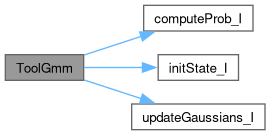Classes | |
| class | CGmmState |
Functions | |
| ToolGmm (V, K, numMaxIter=1000, prevState=None) | |
| helper function: gaussian mixture model | |
| updateGaussians_I (V, p, state) | |
| computeProb_I (V, state) | |
| initState_I (V, K) | |
Function Documentation
◆ computeProb_I()
| computeProb_I | ( | V, | |
| state ) |
Definition at line 72 of file ToolGmm.py.
72def computeProb_I(V, state):
73
74 K = state.mu.shape[1]
75 p = np.zeros([V.shape[1], K])
76
77 # for each cluster
78 for k in range(K):
79 # subtract mean
80 Vm = V - state.mu[:, [k]]
81
82 # weighted gaussian
83 p[:, k] = 1 / np.sqrt((2*np.pi)**Vm.shape[0] * np.linalg.det(state.sigma[k, :, :])) * np.exp(-.5 * np.sum(np.multiply(Vm, np.matmul(np.linalg.inv(state.sigma[k, :, :]), Vm)), axis=0).T)
84 p[:, k] = state.prior[k] * p[:, k]
85
86 # norm over clusters
87 p = p / np.tile(np.sum(p, axis=1, keepdims=True), (1, K))
88
89 return p
90
91
Here is the caller graph for this function:

◆ initState_I()
| initState_I | ( | V, | |
| K ) |
Definition at line 92 of file ToolGmm.py.
92def initState_I(V, K):
93
94 prior = np.ones(K) / K
95
96 # pick random points as cluster means
97 mIdx = np.round(np.random.rand(K) * (V.shape[1]-1)).astype(int)
98
99 # assign means etc.
100 mu = V[:, mIdx]
101 s = np.cov(V)
102 sigma = np.zeros([K, V.shape[0], V.shape[0]])
103 for k in range(K):
104 sigma[k, :, :] = s
105
106 # write initial state
107 state = CGmmState(mu, sigma, prior)
108
109 return state
Here is the caller graph for this function:

◆ ToolGmm()
| ToolGmm | ( | V, | |
| K, | |||
| numMaxIter = 1000, | |||
| prevState = None ) |
helper function: gaussian mixture model
- Parameters
-
V features for all train observations (dimension iNumFeatures x iNumObservations) K number of gaussians numMaxIter maximum number of iterations (stop if not converged before, default: 1000) prevState internal state that can be stored to continue clustering later
- Returns
- mu: means (iNumFeatures x K)
- sigma: standard deviations (K x iNumFeatures X iNumFeatures)
- state: result containing internal state (if needed)
Definition at line 23 of file ToolGmm.py.
23def ToolGmm(V, K, numMaxIter=1000, prevState=None):
24
25 # init
26 if prevState is None:
27 state = initState_I(V, K)
28 else:
29 state = CGmmState(prevState.mu.copy(), prevState.sigma.copy(), prevState.prior.copy())
30
31 for j in range(numMaxIter):
32 prevState = CGmmState(state.mu.copy(), state.sigma.copy(), state.prior.copy())
33
34 # compute weighted gaussian
35 p = computeProb_I(V, state)
36
37 # update clusters
38 state = updateGaussians_I(V, p, state)
39
40 # if converged, break
41 if np.max(np.sum(np.abs(state.mu-prevState.mu))) <= 1e-20:
42 break
43
44 return state.mu, state.sigma, state
45
46
Here is the call graph for this function:

◆ updateGaussians_I()
| updateGaussians_I | ( | V, | |
| p, | |||
| state ) |
Definition at line 47 of file ToolGmm.py.
47def updateGaussians_I(V, p, state):
48
49 # number of clusters
50 K = state.mu.shape[1]
51
52 # update priors
53 state.prior = np.mean(p, axis=0)
54
55 for k in range(K):
56 s = 0
57
58 # update means
59 state.mu[:, k] = np.matmul(V, p[:, k]) / np.sum(p[:, k])
60
61 # subtract mean
62 Vm = V - state.mu[:, [k]]
63
64 for n in range(V.shape[1]):
65 s = s + p[n, k] * np.matmul(Vm[:, [n]], Vm[:, [n]].T)
66
67 state.sigma[k, :, :] = s / np.sum(p[:, k])
68
69 return state
70
71
Here is the caller graph for this function:
